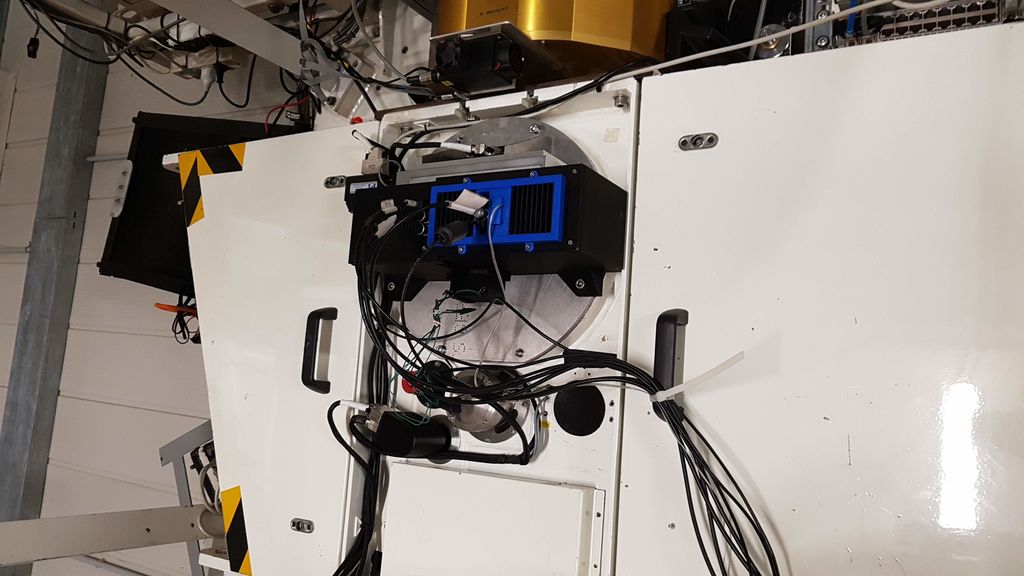
UV and optical signal challenging pulsar models
It is called SAX J1808.4-3658, and it is a pulsar, a neutron star – what is left of stars more massive than the Sun - that emits radiation through two cones of light and rotates very rapidly, making the emission appear pulsating, like that of a lighthouse. But there is more. It is a 'millisecond' pulsar, which means that it rotates even faster than most pulsars, completing 401 revolutions in a single second. It is also in a binary system, orbiting another star from which it regularly removes matter. No doubt, it is also an inconstant celestial object. Indeed, it alternates between phases of "quiescence" and more active or "explosive" periods every 3-4 years: the most recent explosion, the ninth since its discovery in 1996, was recorded between August and September 2019.
During the explosive phase, the luminosity of SAX J1808.4-3658 - about 20 such systems are known to date - increases significantly in the optical and ultraviolet (UV) bands as well as in X-rays, and accretion begins: the other star transfers matter and angular momentum to the pulsar through a disk that extends up to a few kilometres from its surface. This process accelerates the pulsar's rotation and drives accreting matter to its poles, resulting in a pulsed X-ray signal.
"When the start of the new explosion of SAX J1808.4-3658 was announced in August 2019, we wondered whether, in addition to X-band pulsations, the system could also show pulsations in the optical and ultraviolet bands," says Arianna Miraval Zanon, a PhD student at the University of Insubria and an associate at INAF in Milan, Italy, who co-authored with Filippo Ambrosino, a researcher at INAF in Rome, the paper published today in the journal Nature Astronomy. Their curiosity was eventually rewarded. "For the first time, we observed pulsations in the same system, during the explosive phase, with the same rotation period of the pulsar in three different bands: X, UV and optical," adds Ambrosino.
Until then, no UV-band pulsations had ever been observed from pulsars in binary systems. In the optical band, on the other hand, pulsations had only been seen in five isolated pulsars and one binary system, PSR J1023+0038, the latter in a paper signed by Ambrosino himself and several co-authors of the new study; however, it is a different system, which is in an intermediate phase, and therefore only partly resembles SAX J1808.4-3658.
The study is based on UV-band observations made with the Hubble Space Telescope and in the optical band with INAF's Galileo National Telescope (TNG) in La Palma (Canary Islands), equipped with the SiFAP2 optical photometer with very high temporal resolution and absolute accuracy, which is crucial for the discovery of optical pulsations from this system. The prototype of the instrument, SiFAP, had been conceived and developed by Franco Meddi together with Filippo Ambrosino, with the help of Paolo Cretaro at the Department of Physics of Sapienza University of Rome, and already in 2017 had allowed the detection of optical pulsations from the other pulsar mentioned, PSR J1023+0038. Thanks to subsequent collaborations with INAF, with TNG itself and with the University of Catania (particularly with Francesco Leone), the instrument has been improved, taking the name SiFAP2, a new version that will also allow polarimetric studies thanks to a new system of polarising cubes.
However, the new observations pose a dilemma: the brightness of the pulsations measured in the optical and UV bands is too high to be explained, using existing theoretical models, by the accretion of matter on the pulsar. "The pulsed optical and UV signal could therefore be produced in the pulsar's magnetosphere, or not far from it, and be powered by the rotation of the pulsar's magnetic dipole," says Miraval Zanon. "If this were the case, two different physical mechanisms could coexist or alternate very quickly: on the one hand, the accretion would produce X-band pulses; on the other hand, the pulsar, powered by its rotation, would be able to generate optical and UV-band pulses. This scenario challenges the current theoretical models according to which one mechanism excludes the other."
Another exciting aspect raised by the new study is a significant phase shift - just over half a rotation period - observed between the X and optical pulses. "This has given rise to several interpretations," Ambrosino points out, "the most suggestive of which is undoubtedly the possibility that the pulsed X emission comes from one of the two magnetic poles of the pulsar, while the optical pulsation is generated at the opposite pole. This is just a hypothesis; we cannot say anything definitive until we have more extensive statistics on the optical emission from these sources."
In the future, the group plans new observations of this system during the quiescent phase with the SiFAP2 instrument to investigate the possible presence of optical pulsations once the luminosity has decreased: this will help better understand the mechanism that generates them during the explosive phase. A longer-term plan, which has already been approved, is to study the next of twenty such sources to enter the explosive phase, making simultaneous X-ray observations with ESA's XMM-Newton observatory, UV observations with Hubble and optical observations with TNG.
References:
Optical and ultraviolet pulsed emission from an accreting millisecond pulsar - F. Ambrosino, A. Miraval Zanon, A. Papitto, F. Coti Zelati, S. Campana, P. D’Avanzo, L. Stella, T. Di Salvo, L. Burderi, P. Casella, A. Sanna, D. de Martino, M. Cadelano, A. Ghedina, F. Leone, F. Meddi, P. Cretaro, M. C. Baglio, E. Poretti, R. P. Mignani, D. F. Torres, G. L. Israel, M. Cecconi, D. M. Russell, M. D. Gonzalez Gomez, A. L. Riverol Rodriguez, H. Perez Ventura, M. Hernandez Diaz, J. J. San Juan, D. M. Bramich, F. Lewis - Nature Astronomy DOI https://doi.org/10.1038/s41550-021-01308-0
Further Information
Franco Meddi
Department of Physics
franco.meddi@uniroma1.it
